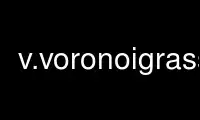
This is the command v.voronoigrass that can be run in the OnWorks free hosting provider using one of our multiple free online workstations such as Ubuntu Online, Fedora Online, Windows online emulator or MAC OS online emulator
PROGRAM:
NAME
v.voronoi - Creates a Voronoi diagram in current region from an input vector map
containing points or centroids.
KEYWORDS
vector, geometry, triangulation, skeleton
SYNOPSIS
v.voronoi
v.voronoi --help
v.voronoi [-aslt] input=name [layer=string] output=name [smoothness=float]
[thin=float] [--overwrite] [--help] [--verbose] [--quiet] [--ui]
Flags:
-a
Create Voronoi diagram for input areas
-s
Extract skeletons for input areas
-l
Output tessellation as a graph (lines), not areas
-t
Do not create attribute table
--overwrite
Allow output files to overwrite existing files
--help
Print usage summary
--verbose
Verbose module output
--quiet
Quiet module output
--ui
Force launching GUI dialog
Parameters:
input=name [required]
Name of input vector point map
Or data source for direct OGR access
layer=string
Layer number or name (’-1’ for all layers)
A single vector map can be connected to multiple database tables. This number
determines which table to use. When used with direct OGR access this is the layer
name.
Default: -1
output=name [required]
Name for output vector map
smoothness=float
Factor for output smoothness
Applies to input areas only. Smaller values produce smoother output but can cause
numerical instability.
Default: 0.25
thin=float
Maximum dangle length of skeletons
Applies only to skeleton extraction. Default = -1 will extract the center line.
Default: -1
DESCRIPTION
v.voronoi creates a Voronoi diagram (Thiessen polygons) from points or centroids.
The bounds of the output map are limited by the current region (see g.region).
The -a flag can be used to create a Voronoi diagram for areas.
The -s flag can be used to extract the center line of areas or skeletons of areas with
thin >= 0. Smaller values for the thin option will preserve more detail, while negative
values will extract only the center line.
NOTES
Voronoi diagrams may be used for nearest-neighbor flood filling. Give the centroids
attributes (start with v.db.addcolumn), then optionally convert the result to a raster map
with v.to.rast.
The extraction of skeletons and center lines with the -s flag is a brute force approach.
Faster and more accurate algorithms to extract skeletons from areas exist but are not yet
implemented. In the meantime, skeletons and center lines can be simplified with the
Douglas-Peucker algorithm: v.generalize method=douglas.
EXAMPLE
Voronoi diagram for points
This example uses the hospitals in the North Carolina dataset.
g.region -p raster=elev_state_500m
v.voronoi input=hospitals output=hospitals_voronoi
Result:
Voronoi diagram for hospitals in North Carolina
Voronoi diagram for areas
This example uses urban areas in the North Carolina dataset.
g.region -p n=162500 s=80000 w=727000 e=846000 res=500
v.voronoi input=urbanarea output=urbanarea_voronoi -a
Result:
Voronoi diagram for urban areas in North Carolina
Skeletons and center lines of areas
This example uses urban areas in the North Carolina dataset.
g.region -p n=161000 s=135500 w=768500 e=805500 res=500
v.voronoi input=urbanarea output=urbanarea_centerline -s
v.voronoi input=urbanarea output=urbanarea_skeleton -s thin=2000
Result:
Skeleton (blue) and center line (red) for urban areas in North Carolina
REFERENCES
Steve J. Fortune, (1987). A Sweepline Algorithm for Voronoi Diagrams, Algorithmica 2,
153-174 (DOI).
Use v.voronoigrass online using onworks.net services
